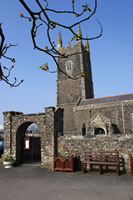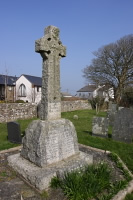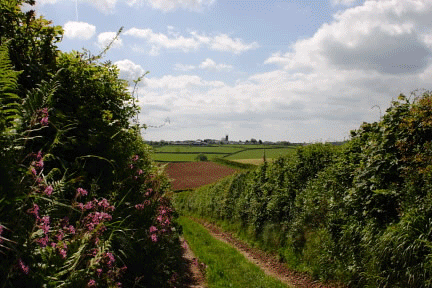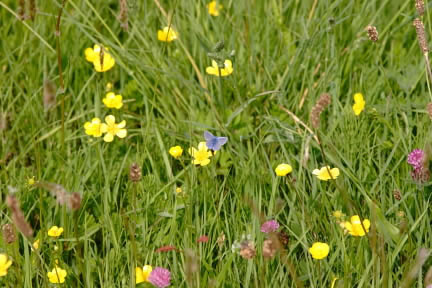|
|
Green
lanes, green fields, golden gorse and bluebell woods welcome to the Parish
of Parkham which sweeps upwards from the North Devon Heritage Coast between
Peppercombe and Bucks Mills. The parish rolls south through tiny hamlets
including Northway, Horns Cross, Foxdown,
Hoops, Newhaven, Goldworthy, Ash and Broad Parkham widening like an outstretched
hand to the outer limits from Yeo Vale to Powlers Piece and the Melbury
Forest. This is farming country enhanced by sheltered valleys and ancient
woodland, traditional high-banked Devon hedgerows and wild flower meadows.
It is possible to walk the length of the Parish along the Southwest
Coast Path which meanders high above Peppercombe, through Sloo and
Worthygate Woods and down to the parish boundary marked by a stream at Bucks
Mills. The "King of Bucks Mills", Captain James Braund no longer
reigns but the lime kiln, "East Kiln" is still standing proud.
In olden times when lime was used to fertilise the fields it took two or
three horses to haul a cart full of lime up the steep slope from the beach.
Peppercombe Hamlet was important years
ago because it had a coastguard station. There was once a "castle"
perched on the cliff edge above the beach which was said to be occupied
until around 1908. What was once a tennis lawn below the castle is now Peppercombe
Meadows where wild flowers abound during Spring and Summer. Both the Peppercombe
lime kiln and the castle were swept away a long time ago but remnants of
the walls are still just visible under the mass of vegetation. Horns Cross,
on the A39 Atlantic Highway, sits astride the boundary between Alwington
and Parkham. The many public footpaths which criss-cross the parish make
it possible to walk right through this spectacular countryside to Parkham
Village. At one high point it is possible to scan the panorama and see the
spires of three adjacent parish churches Alwington, Buckland Brewer and
Parkham. Melbury Forest, almost 629 feet above sea level, can also be seen
in the distance. Parkham village today has a butchers shop, a pub, a school,
a hotel and a village hall. Allardice Hall, which celebrated its 50th Anniversary
in 2007 is used regularly by community groups, chapel, church and school
for a host of fun and fundraising events. In 2010, after four years of fundraising,
the village hall roof was renewed and solar panels now generate electricity
to power the building. The parish church of St. James is in a peaceful setting
behind what was once the Village Green and has an 84 feet high tower. G.
E. Honey & Son Butchers was established in 1902 and is still supplying
quality meat from its shop in Parkham. Previously they traded in Mill Street,
Bideford where they relocated in 2000 after many years trading from premises
on Butchers Row in Bideford Pannier Market. Their little van is still delivering
to rural customers around the Bideford area. There are three long established
pubs in the parish serving good food and real ales, the Coach and Horses
at Horns Cross, the Hoops Inn a little further down the A39 and the Bell
Inn in Parkham village itself. In the early 1900s the Rector, Parson Smart
and his wife lived at the Rectory which is now the Penhaven Hotel. They
had a carriage and employed a coachman, butler, three maids and a couple
of gardeners. How times have changed. Although job descriptions and farming
practices have evolved, annual rural traditions still hold and the seasons
are still marked by flower strewn or berry packed hedgerows, the growth
and colour of barley, corn and wheat crops before harvest time. Hedge trimming
precedes ploughing the fields and scattering "the good seed on the
land". In the Autumn, gulls feast, flap and squawk on newly ploughed
red earth. Snow flurries announce the imminent arrival of winter flocks
of migrating birds. Buzzards and Peregrine Falcons watch patiently as fieldfare
and lapwings trundle along between the fresh green shoots. Golden gorse
in January, snowdrops in February, primroses in March, the return of House
Martins, Swallows and Swifts in April, bluebells in May, mid-summer fetes,
agricultural shows and harvest festivals. This really is "Home to the
Countryman".
Historical Information: George Jacob C1979 Looking Back On Parkham
& Bideford Of Years Ago available Bideford Library. Parish of
Parkham past notable estates & landlords: Stevenstone, Hon. Mark
Rolle, Pine Coffin, Kakewich, Eles, Foxdown Manor, James Paton, Squire Rogers
of Orleigh Court, Buckland Brewer
(to whom Henry Williamson dedicated his book "Tarka the Otter")
Stevenstone Hunt dates from 1859, before which it was known as the North
Devon Hunt
Hymn: We Plough the Fields And Scatter Words by Matthias Claudius
(1740-1815) Translated by Jane Montgomery Campbell (1817-78)
|
|
















